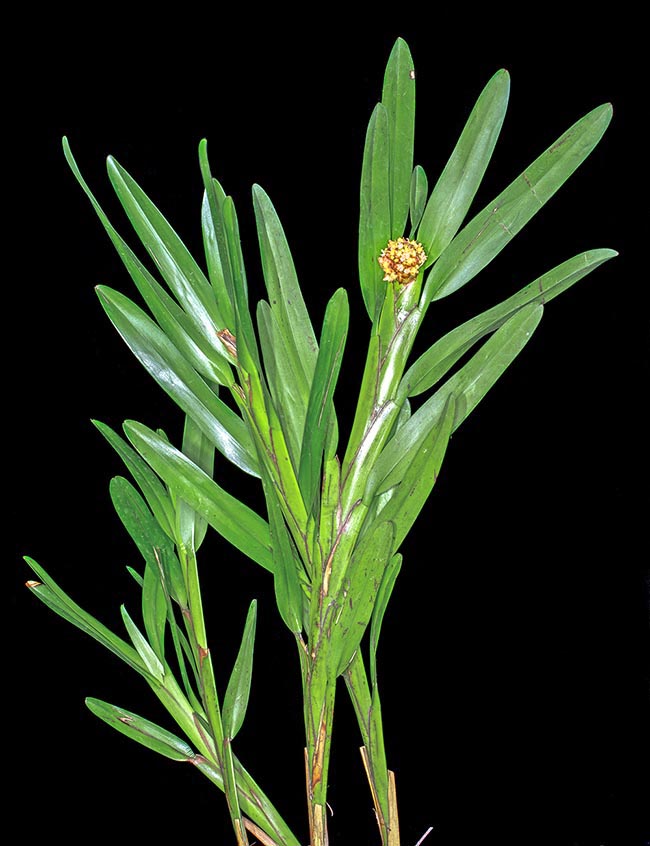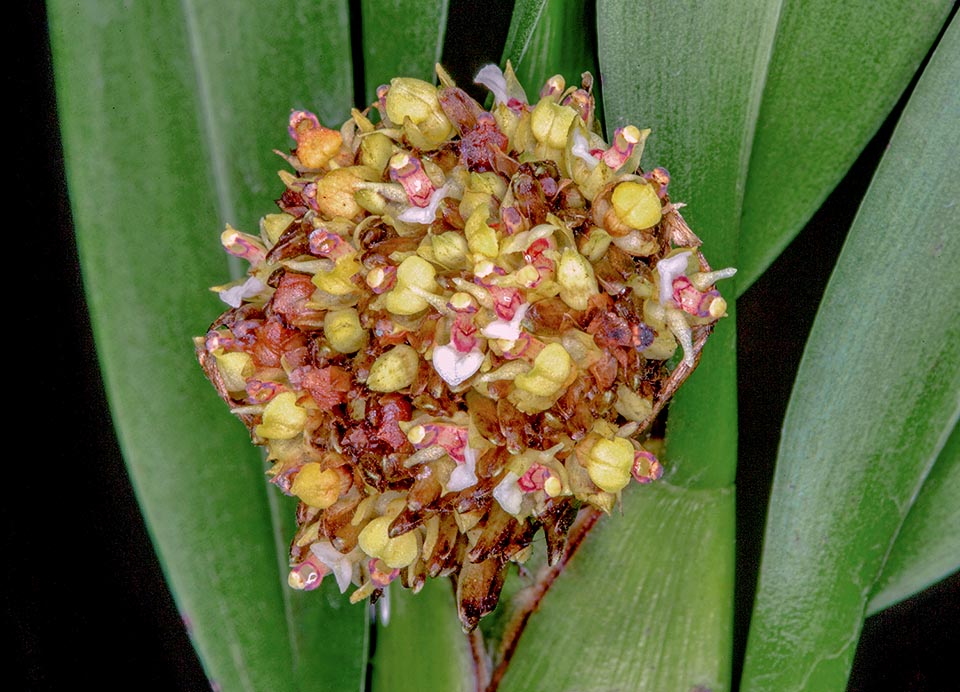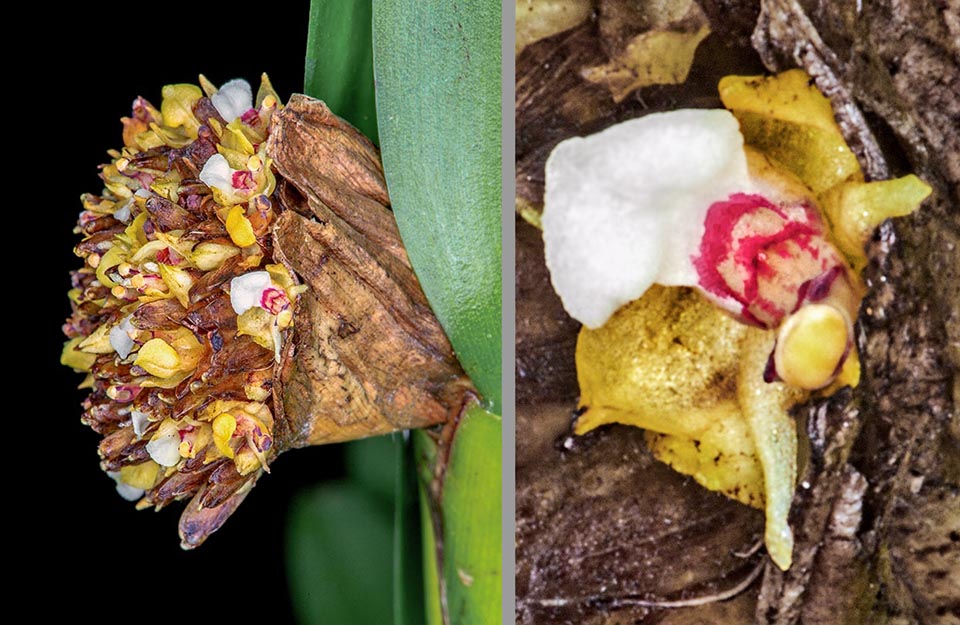Family : Orchidaceae

Text © Prof. Pietro Pavone

English translation by Mario Beltramini

Agrostophyllum majus grows mainly in altitude as epiphyte, but at times also on mossy soil, in the humid tropical forests of Thailand, Borneo, Java, Malaysia, Sumatra, Solomon Islands, Sulawesi and Vanuatu © Giuseppe Mazza
Agrostophyllum majus Hook.f. (1890) is a species included in the tribe Epidendreae and in the subtribe
Agrostophyllinae, belonging to the family Orchidaceae.
It has been reported in Thailand, Borneo, Java, Malaysia, Solomon Islands, Sulawesi and Vanuatu, at an altitude between 200 and 1500 metres.
Agrostophyllum majus grows chiefly in the humid tropical forests on trunks or on branches of trees even dead. It is often confused with Agrostophyllum longifolium (Blume) Rchb.f., that shares its same range, but this last differs due to the size of the leaves and the shape of the labellum.
The genus Agrostophyllum comes from the Greek words“ἄγρωστις” (ágrostis), grass and “φύλλον” (phýllon), leaf, because of the grass-like appearance the leaves confer it.
The specific epithet comes from the Latin “majus”, greater and refers to the size of its leafy branches.
The genus Agrostophyllum, formed by about 100 species, has a disjointed range.
As a matter of fact, its species are present on the western side of the Indian Ocean (Madagascar and Seychelles Islands) as well as on the eastern side of the Indian subcontinent (southern China and Taiwan, Indochina, Philippines, Indonesia, New Guinea, Caroline islands, Fiji, New Caledonia, Samoa and Vanuatu).
The Kelabit people of the territory Sarawak (Malaysia) wear the inflorescences of some species of the genus as a spell to protect themselves from curses.
Agrostophyllum majus is usually an epiphyte, but there are populations growing also on the litter or on the moss of the soil in open sites, at 1350-1500 metres above the sea level (Sicike-cike Natural Park, North Sumatra). In North Samosir (North Sumatra) the species has been found at an altitude of 1557 m where the temperature of the air was standing between 15-19 °C and the soil has a pH 5. On the granite outcrops of Mount Jerai (Gunung Jerai) in north-western peninsular Malaysia, at 900 m of altitude, this species is also a lithophyte.
Agrostophyllum majus is a herbaceous species with a leafy appearance, having no pseudobulbs, with erect, up to 1 m long, thin stems, flattened bilaterally, with 2-4 cm long internodes.

Herbaceous species with leafy look, without pseudobulbs, has flattened erect stems, up to 1 m long, with 2,5-3 cm apical globose inflorescences © Giuseppe Mazza
The stems rise from the robust rhizome, up to 75 cm long, and bear leaves distant about 3,5 cm from each other. They have a disthic disposition and form an acute angle with the stem. They are numerous, big, 10-18 x 1,6 cm. The laminae, bordered in black or brown, vary from narrow and oblong to linear- lanceolate, being the lower smaller than the upper ones, with overlapping sheaths (imbricate) wrapping the stem.
The inflorescences, all apical, have the shape of globose capitula, of 2,5-3 cm of diametre, formed by bracts having numerous flowers.
The flowers, typically resupinate, are small, from 0,5 to 0,7 cm with free sepals and petals of pale yellow colour, crimson on part of the lip and on the edges of the column. The 2 x 1,3 mm dorsal sepal is erect, little acuminate. The lateral sepals, like the dorsal, are expanded, keeled on the back.

Dramatic image of an inflorescence seen from the side and detail of a flower measuring only 5-7 mm © Giuseppe Mazza
The petals are as long as the sepals but narrower. The lip measures about 2,5 mm, is usually entire with saccate base. The about 3 mm column is curved with an enlarged base and rudimental foot. The pollinodia, normally 8, are waxy, with a short caudicle on the viscidium. The stigma is concave. The rostellum is sub triangular and voluminous.
The fruits are capsules that release several seeds.
This orchid can grow in the cold climates but is little cultivated as an ornamental plant excluding some Orchards and Botanic Gardens.
Synonyms: Agrostophyllum agusanense Ormerod; Agrostophyllum denbergeri J.J.Sm.; Agrostophyllum indifferens J.J.Sm.
